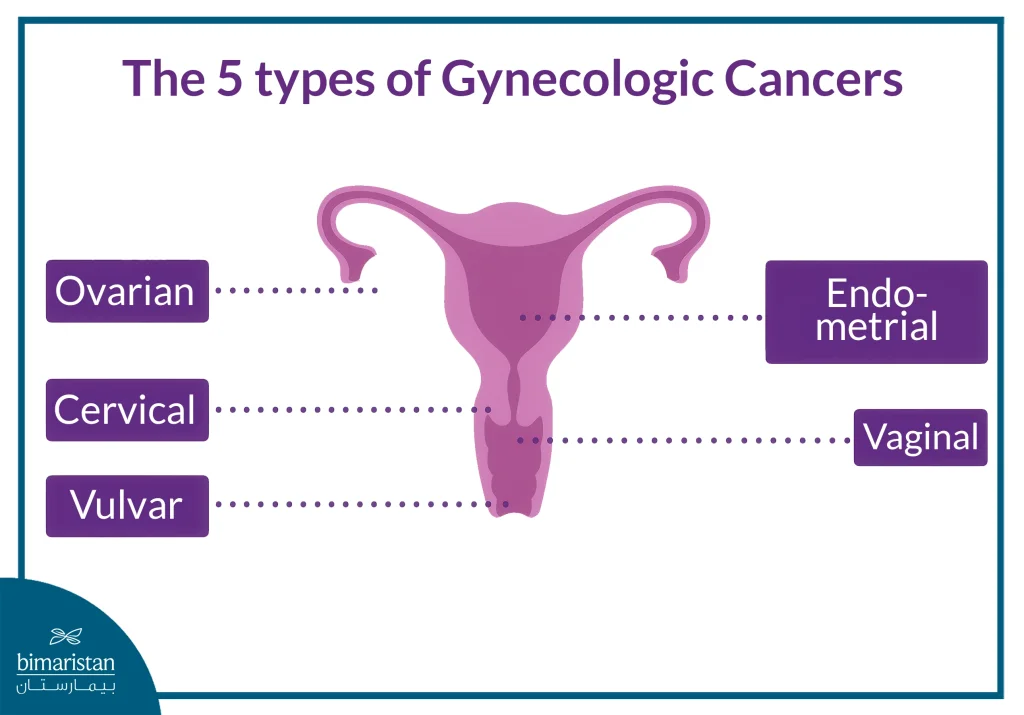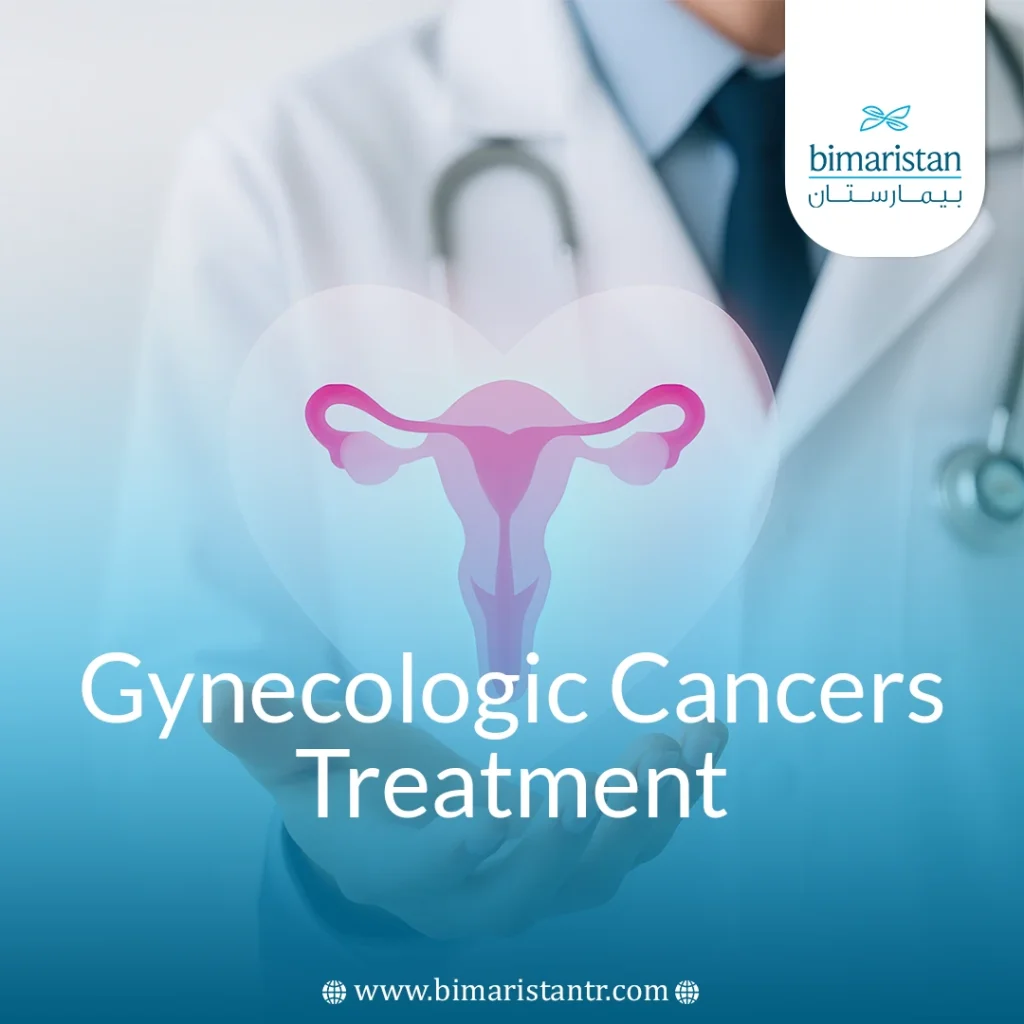Gynecological cancers include a group of tumors that affect a woman’s reproductive system, such as cancer of the cervix, ovaries, uterus, vagina, and vulva. Gynecologic cancer treatment methods vary according to the type and stage of cancer, and with the development of medicine, multiple options have emerged, including surgery, chemotherapy, radiation, immunotherapy, and targeted therapy. In this article, we discuss the most prominent methods of gynecologic cancer treatment according to each type, and explain the cure rates and modern techniques used.
What types of gynecological cancers require specialized treatment?
Cervical cancer
Cervical cancer develops in the cells lining the cervix and is often associated with HPV infection. It develops slowly and goes through pre-cancerous stages that can be detected early through screening tests, and symptoms may not appear at first, but later may include abnormal bleeding or pain. It is a preventable cancer through vaccination and regular screening.
Ovarian cancer
Ovarian cancer usually starts in the ovaries or may start in the fallopian tubes and is known as the silent killer due to its vague symptoms. This cancer is divided into several types, such as epithelial and adenocarcinoma. It is associated with genetic factors, such as BRCA1 and BRCA2 mutations, and some of its symptoms show similarities to non-cancerous diseases, including polycystic ovary syndrome, which makes early diagnosis difficult. Therefore, it is essential to accurately differentiate between the two conditions.
Endometrial cancer
This cancer originates in the inner membrane of the uterus and is one of the most common cancers of the female reproductive system. It is often associated with increased exposure to estrogen without a balance of progesterone and post-menopausal vaginal bleeding is the most common symptom. It is usually diagnosed in the early stages because the symptoms are obvious.
Vulvar cancer
Vulvar cancer affects the outer skin of the female genitalia and often begins in the labia, mostly of the squamous cell type, and is sometimes associated with HPV infection. It may present as an ulceration, lump, chronic itching, or unexplained bleeding. This cancer is relatively rare and tends to occur more frequently in post-menopausal women.
Vaginal cancer
It is a rare type of cancer that affects the inner lining of the vagina and occurs mostly in women over the age of 60, in many cases associated with HPV infection, causing no obvious symptoms at first but later bleeding, pain or a lump inside the vagina. Common types include squamous carcinoma and the less common adenocarcinoma.

Cervical cancer treatment
Surgery in the early stages
Surgery is the primary option for early cases of cervical cancer, where the tumor is removed while preserving reproductive capacity in some cases, such as a segmental or complete cervical resection, and is considered very effective before the disease spreads.
Concurrent radiation and chemotherapy
Concurrent radiation and chemoradiotherapy is the mainstay in advanced stages and is considered highly curative in many cases, especially when combined with targeted or immunotherapy.
Advanced immunotherapy for relapse
Immune checkpoint inhibitors such as pembrolizumab and nivolumab are approved for relapsed cases and have shown improved durable responses in patients who have not responded to conventional therapy.
HPV vaccine and its role in the prevention and gynecologic cancer treatment
It prevents many associated cancers, including the cervix, and significantly reduces the incidence; it is not used to treat gynecologic cancers but is a primary means of early prevention.
Ovarian cancer treatment
Surgery and tumor removal
Surgery is the primary step in the treatment of ovarian cancer as it ensures that the uterus, ovaries, and fallopian tubes are removed while removing as much of the tumor as possible to improve the chances of recovery.
Chemotherapy that used after surgery
Chemotherapy often consists of carboplatin and paclitaxel, and is given after surgery in several cycles to control the remaining cells and minimize the risk of relapse.
Targeted therapy with PARP inhibitors
PARP inhibitors such as olaparib and niraparib are used especially in cases resulting from BRCA mutations or defective DNA repair and have shown efficacy in delaying the progression of the disease.
Recovery rates by stage
The cure rate is high in the early stages and may reach almost 90%, while it is lower in the advanced stages to be between 17% and 40%, depending on the extent of the disease.
Endometrial cancer treatment
Total or partial hysterectomy
The primary treatment involves the removal of the uterus, and sometimes the cervix, ovaries, and fallopian tubes, whether total or partial, to determine the stage of the cancer and remove the tumor.
Hormone therapy for early cases
The hormone progestin is used as a replacement or temporary option in early cases, especially in women who wish to preserve fertility, and is administered under close medical supervision.
Brachytherapy after surgery
Brachytherapy or external beam radiation therapy is used as an adjuvant treatment after surgery to reduce the risk of relapse in cases that are categorized as high-risk.
Gynecologic cancer treatment options during pregnancy
Is it possible to get pregnant with treatment?
In most cases, it is possible to continue a pregnancy while receiving treatment, provided the disease is at a manageable stage. The decision is made according to the type of cancer and the stage of the pregnancy, taking care to protect the fetus.
When is treatment postponed after childbirth?
Treatment of gynecological cancers is postponed if the cancer is slow-growing or at an early stage and can wait until the baby is born, especially in the first trimester, to avoid the effect of drugs on organogenesis.
Safe protocols for pregnant women
Surgery is safe after week 14, and chemotherapy is possible in the second and third trimesters, while radiation is completely banned during pregnancy due to its harmful effects on the fetus.
Latest treatments for gynecologic cancers in 2025
Immunotherapy: Efficacy and side effects
Immune checkpoint inhibitors such as Pembrolizumab, officially approved by the FDA for the treatment of recurrent or metastatic cervical cancer with PD-L1 expression, and Nivolumab have shown efficacy in the gynecologic cancer treatment of relapsed or advanced cases. They achieve satisfactory response rates similar to those in patients within or outside the radiation injury zone without a decline in the progression-free survival rate. Dostarlimab also shows high response in patients with dMMR/MSI-H endometrial cancer, with moderate side effects including skin rash and fatigue.
Gene and mutation-targeted therapies
Genetic approaches include treatment with PARP inhibitors such as olaparib and niraparib, as well as EZH2 inhibitors such as tulmimetostat, in clinical trials for patients with advanced ovarian cancer, BRCA mutation, or DNA repair dysfunction. Drug-drug conjugate (ADC) antibodies such as tisotumab vedotin have also been initiated for the treatment of treatment-resistant cervical cancer.
How to choose the right gynecologic cancer treatment center
Medical criteria for hospital selection
Choosing the right center for gynecologic cancer treatment requires the availability of a specialized gynecological oncology unit, as well as a multidisciplinary medical team and international accreditation. It is also important that the center includes advanced diagnostic and therapeutic techniques, expertise in complex cases, and psychological and reproductive support services.
Are gynecological cancers treated in Turkey?
Turkey has become a prominent medical destination for gynecologic cancer treatment thanks to its extensive experience, specialized staff, and international accreditation, in addition to providing a safe, upscale, and touristic treatment environment at competitive prices.
With medical advances, gynecologic cancer treatment has become more effective and hopeful, especially with early detection and proper protocols. Surgery, chemotherapy, and radiation are the mainstays of gynecologic cancer treatment, but today there are more precise and less harmful targeted options. Consult with a medical professional to evaluate your condition and choose the most appropriate treatment for your life and future quality of life.
Sources:
- Centers for Disease Control and Prevention. (2024, September 5). Gynecologic Cancer Treatment U.S. Department of Health and Human Services.
- Andersen, B. L., & Hacker, N. F. (1983). Treatment for gynecologic cancer: A review of the effects on female sexuality. Health Psychology, 2(2), 203-211.
